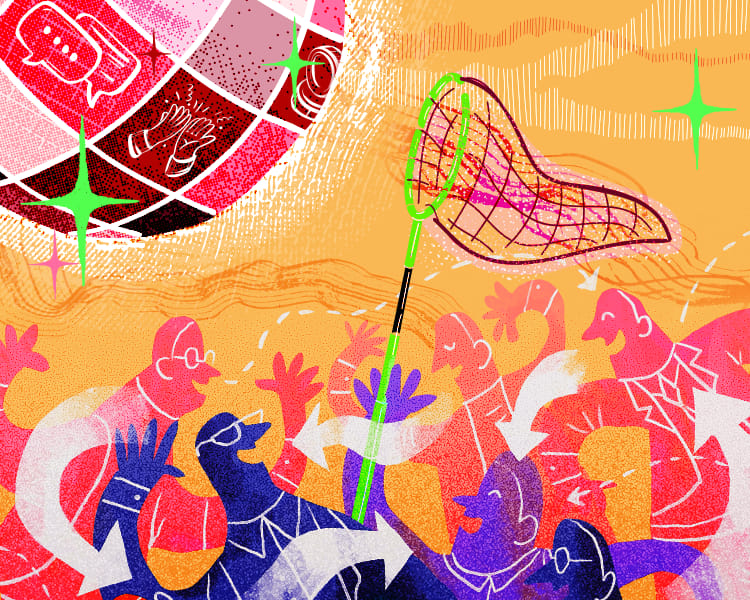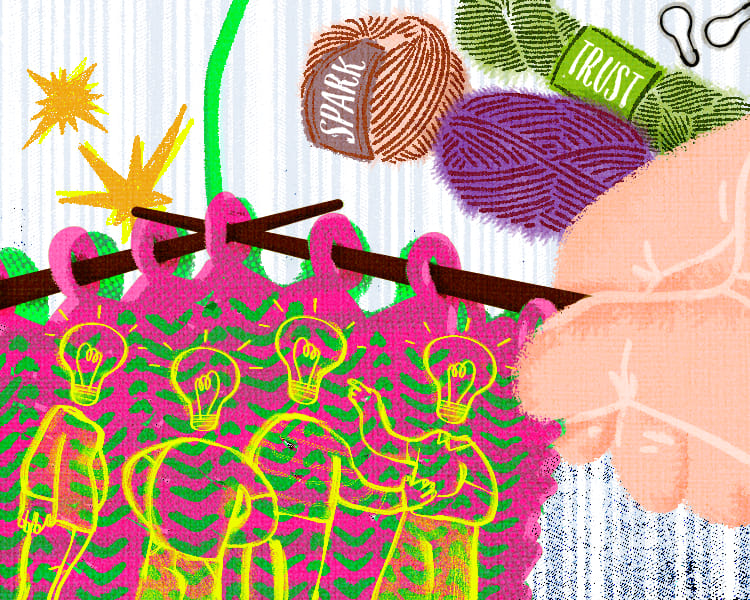- The B2B Marketing Brief
- Posts
- Why Events Are B2B Marketing’s Best Stage
Why Events Are B2B Marketing’s Best Stage
Welcome to The B2B Marketing Brief! Your front-row seat to the ever-evolving world of B2B marketing. Where we keep it real—sharing wins, tackling pain points, and uncovering growth opportunities. Each edition is packed with stories, tips, and the latest trends to help you master the art of B2B engagement. Get your cup of coffee, and let’s get marketing!
In this issue:
Your Event's Got Great Vibes—Turn Them Into Pipeline
Not Just a Stage: How B2B Events Build Trust, Spark Emotion, and Drive Growth

Your Event's Got Great Vibes—Turn Them Into Pipeline
 |
Ah, marketing events. The awkward handshakes, coffee convos, finicky badge scans, and killer swag. They let us talk shop with other marketing whizzes, trade campaign ideas, and get IRL face-time with prospects. But that’s not all they are.
According to Forrester, 49% of CMOs say events are more important today than before the pandemic. And for good reason: they can capture rich, real-time intent from buyers in ways digital campaigns alone can't.
So why do marketing teams still treat event data like a post-mortem? Well, acting on that data quickly is easier said than done. Most teams don’t have streamlined access to event metrics, and a lot of this technology is still new or locked behind expensive platforms 👀
We think the future of real-time intent data is seriously cool. But you also don’t need a hyper-connected martech stack to do better.
Real-Time Intent is Your Backstage Pass to Buyer Readiness
Today’s most advanced event tech can track session attendance, booth dwell time, poll responses, resource downloads, badge scans, app engagement, live chat interactions, and even participation in Q&As or breakout rooms.
Why the deep dive into event ones and zeros? Gartner tells us that 83% of the typical B2B buying journey happens before a buyer engages directly with a sales rep. This pre-sales engagement extends to the time during and immediately after events, as well.
And while most teams aren’t wired to use all of that data in real time, that doesn’t mean you can’t work with what you've got. Even faster-than-average beats same-old-slow. Acting on signals while the event is still happening (or right after) can:
Find patterns in how buying teams engage
Route high-value accounts to the right play and channel
Turn an engaged conversation into a pipeline opportunity
Make sense?
One great example came from Liz McComas, our AVP of Digital Media, during the Wednesday Women coffee meet-up at this year’s SaaStr Conference in San Mateo, CA. “The meet-up sparked several conversations with other women leaders in marketing, including a follow-up with a potential SEO lead,” Liz explains. “It’s a good reminder that even casual connections—like a coffee chat—can lead to meaningful opportunities.”
Stop Sitting on Your Signals and Start Making Them Work
You don’t need a 15-tool stack to pull off smart mid-event outreach. But you do need a shared plan and a bias for action. Here’s a playbook that works:
1. Aggregate and align your data
Pull what you can, from badge scans and app logs to booth notes and survey responses. Even a shared Google Sheet can be a step up.
2. Automate by behavior, not just persona
Set triggers by signal type. Attended a pricing session? Drop them into a mid-funnel email stream. No automation? No problem. Assign someone to tag high-intent attendees each day and prep next steps.
3. Tailor the message to the moment
Ditch the rote follow-ups. Customize copy and CTAs based on the content attendees interacted with, rather than generic post-event push messaging.
4. Score for relevance and reach
Predictive scoring can spotlight which accounts are showing heat and which are just browsing. If you’ve got it, use it to focus spend and sales effort.
5. Give sales the lead and the ammo
Push summaries into your CRM. Make it easy to know who did what, and what to say next.
Another example: We use Qualified’s Piper tool for inbound chat, where it helps identify whether a visitor is part of our TAL or attended a recent event. Our Marketing Technology Manager Corinne Tippett notes, “One of our clients uses these insights to deliver differentiated experiences. Piper references this data to tailor everything from chat introductions to content offers to routing.”
It’s one of the ways even light event data—like who visited your booth or downloaded a session resource—can carry through to onsite engagement and live chat follow-ups that feel more impactful.
Make Event ROI Less "Meh" and More "Mic-Drop"
Intent-led campaigns can seriously improve lead quality. That’s because teams get to work from data-driven signals rather than outdated personas or guesswork. That said, don’t go overboard 🚢 Respect timing and tone. Hammering someone with three follow-ups in 12 hours can hurt more than help.
What makes event intent data uniquely powerful is its immediacy and specificity. Even without fancy predictive AI or full automation, you can use:
Dynamic segmentation: Group by behavior instead of just job title
Sequential messaging: Plan 3-4 touches that build context instead of urgency
Content prioritization: Personalize with a partner like PathFactory or Mutiny to ensure your landing pages reflect the offer and themes from the event.
Our head of Marketing, Gina Inks notes, “With PathFactory, we turn static follow-up into smart, personalized content journeys that match what your prospects saw at the event—so they keep clicking, learning, and converting, all in one seamless flow.”
Bottom line? When you pair real-time intent with personalized, event-aligned content, you’re not just following up—you’re following through. And that’s what turns booth buzz into actual pipeline.
Final Word: Events Are Loud. Intent Is the Signal.
Every booth visit, download, and session question is a window into what your buyers need. When you act on those signals, you turn fleeting interest into momentum. The good news? Not every tool needs to be cutting-edge. Not every signal needs to be instant.
But for teams who are ready to shift from passive collection to proactive engagement, event intent data offers an exciting edge. It offers the opportunity to follow up faster and more meaningfully, while your message is still fresh.

Not Just a Stage: How B2B Events Build Trust, Spark Emotion, and Drive Growth
 |
In an age of endless clicks, scrolls, and inbox noise, there’s one marketing experience that still stops people in their tracks: a well-crafted event.
Whether it’s a buzzing industry conference, a curated virtual roundtable, or a hyper-personalized CXO dinner, events have become the grand theatres of modern B2B marketing. They are where brands step out of the shadows of digital sameness and into the spotlight of emotional resonance, real connection, and lasting impact.
So why do events matter more than ever in 2025? Why, in a world of AI-generated content and hyper-personalization, are CMOs doubling down on human interaction?
Let’s pull back the curtain.
Act 1: From Transactions to Transformations
At their core, B2B events aren’t about booths, brochures, or badge scans. They're about transformations. For a few hours—or a few days—they transport prospects and customers from their inboxes into immersive brand experiences. They give shape, sound, and soul to a brand.
In a landscape oversaturated with digital noise, people are seeking more than pitches. They want to be surprised, understood, and inspired. Events offer the chance to meet someone new over coffee who could become a strategic partner, to touch and try products that previously only existed on screen, and to have conversations with real people—not automated workflows.
Trust, which is becoming the most valuable currency in B2B marketing, is forged not through perfectly worded emails, but through shared experience. And events are still the best arena for building it.
Act 2: From Lead Factories to Community Arenas
Let’s be honest. For a long time, events were treated like lead-hunting expeditions. Booths became traps, and follow-ups felt more like automated chases than genuine engagement.
That model is crumbling—and rightfully so.
Today’s most successful marketers are embracing a different mindset. Instead of volume, they’re focusing on belonging. Rather than building booths, they’re building communities. The rise of curated CXO roundtables, intimate thought-leadership salons, and industry-specific forums reflects this shift. Brands are shedding their hard-sell image and stepping into roles as collaborators, conveners, and listeners.
One strong example is Adobe Summit, which has transformed from a traditional showcase into an ecosystem of big ideas and shared vision. Sessions focus less on software specs and more on human stories—from digital ethics to inclusive design. Here, Adobe is not merely selling solutions—it’s curating perspectives.
Similarly, HubSpot INBOUND has redefined what it means to host a business event. It blends tactical workshops with TED-style storytelling, creating an environment where both marketing rookies and seasoned executives find value. INBOUND doesn’t just attract people—it assembles a movement.
Act 3: Hybrid Isn’t a Format. It’s a Mindset.
In the immediate aftermath of the pandemic, marketers wrestled with an either/or question: in-person or virtual?
Now, the savviest among them have stopped choosing.
Hybrid isn’t a fallback—it’s a creative mindset. Done right, it dissolves the boundaries of geography and format. It allows a participant in Singapore to feel just as engaged as someone seated in the front row in San Francisco. It’s not just about live-streaming a panel, but about designing an experience that translates seamlessly across both spaces.
This requires thinking ahead—designing moments that are modular, formats that are immersive, and content that lives beyond the screen. Brands that invest in this kind of hybrid intelligence aren’t just expanding their audience; they’re enriching the experience for everyone involved.
Act 4: Events as Content Engines
Events don’t end when the lights go down. In fact, that’s when the real magic begins—for marketing.
Each keynote, panel, and breakout session is a wellspring of content. When repurposed with intention, these moments feed entire content ecosystems—blogs, podcasts, newsletters, sales enablement tools, and social storytelling. What begins as a single panel can ripple into months of meaningful engagement.
Think of it as creative compounding. The unscripted insight from a guest speaker becomes a shareable quote. A live demo turns into a YouTube tutorial. A hallway conversation sparks a customer story. Events are no longer a spike on the calendar—they're an engine driving long-term narrative momentum.
Act 5: Measuring the Right Applause
Historically, event ROI was reduced to badge scans, business cards, or lead counts. But modern marketers are looking deeper—and broader.
Are people talking about you differently post-event?
Are top accounts engaging in the days and weeks that follow?
Is your event content performing in the long tail?
Is your community growing—not just in size, but in strength?
And most importantly: did your audience feel something?
Because the most powerful thing an event can leave behind isn’t swag. It’s a story, a shift, a spark.
Epilogue: Designing for Goosebumps
If B2B marketing is a stage, then events are its showstoppers. They are where logic meets emotion, where brands go from being noticed to being felt.
But unforgettable events don’t happen by accident. They are the result of careful design, emotional intelligence, and relentless attention to detail.
So, as you plan your next one, don’t start with a lead goal. Start with a question: What kind of experience will they remember?
The best events don’t chase conversions. They spark conversations. They turn attendees into advocates and audiences into communities.
And in a world where everyone is talking, the brands that make people feel something—live or virtual—are the ones that people remember.
The spotlight’s on. What story will you tell?
Up Next: ROI·DNA Reveals How Events Turn Brand Goals into Action.
Catch our next issue out on July 30 2025!
 |  |
Reply